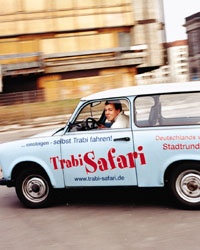 Christian Kerber
In Berlin, Communist kitsch is inspiring a new generation of Germans, nostalgic for the days before the fall of the wall.
Christian Kerber
In Berlin, Communist kitsch is inspiring a new generation of Germans, nostalgic for the days before the fall of the wall.
Almost 15 years after the fall of the Ber-lin Wall, the German Democratic Republic, a vanished country, has become a state of mind. Young people who were only children when the wall was up are throwing "Ost Partys" and chugging Rotkäppchen, East German bubbly. Pictures of Karl Marx and former GDR leader Erich Honecker hang on the walls of Ostzone, a very funky bar that—like all cult hangouts—opens and closes without warning. At the Prenzlauer Berg secondhand shop Mega Trend Humana, the pièce de résistance is a purple nylon wraparound dress, last seen in an East Berlin disco circa 1979. And over at Schönhauser Design—where people scavenge the back room for old orange plastic lamps and black leatherette sofas—I find myself coveting a pair of authentic Communist sunglasses.
The trend is called Ostalgie, and it means nostalgia for the East, as in the socialist East German state that fell soon after the wall came down in November 1989. Nowhere has Ostalgie been expressed with more wit, humor, and irony than in Good Bye Lenin! the recent Golden Globe-nominated German film. The characters are obsessed with the good old, bad old days of their youth: the clothes, the patriotic songs, even the food. The hero spends the film searching for Spreewald pickles—a brand beloved by East Germans—for his Communist mother, who emerges from a coma and doesn't know the wall has fallen. It's a funny, moving portrait of the period; like the Ostalgie phenomenon itself, the movie is about coming to grips with childhood, memory, and history.
In the unified Germany of the 21st century, there is high unemployment and high anxiety, especially in what was once the East. Ostalgie represents a yearning for another time, when—in the rosy glow of hindsight—everyone had a job and there was more leisure time, less capitalist frenzy, and fewer assaults from a celebrity-crazed media. There is even nostalgia for the Trabant, the East German car made from 1955 to 1991 and constructed mostly of plastic. Discarded with disdain in the months after the wall came down, the Trabi has become a sentimental icon. Intrepid tourists can embark on a Trabi-Safari, a drive-yourself tour of Berlin. (I once navigated a robin's-egg-blue Trabant through Germany; it was a sardine can on wheels.)
Back in the 1980's, when the Berlin Wall not only separated the city but also defined the world, I visited East Berlin half a dozen times. It looked as it was: repressive, gray, frightening, a place locked in for 28 years by its own government. Almost a mile of that wall is left; it runs along Mühlenstrasse and is decorated with murals celebrating its fall, a kind of outdoor gallery. Needless to say, the original wall was topped with barbed wire, watched over by soldiers in towers with guns and dogs, and its purpose was not art.
For a while, as the Eastern bloc crumbled, I, too, was taken with Communist kitsch. It seemed a delicious nose-thumbing gesture to possess a forbidden piece of the system—a bust of Lenin, or a military uniform. I'm mesmerized by this new, mocking nostalgia for the East, which crops up at places like White Trash Fast Food, a late-night bar in the fashionable Mitte district, with great cheeseburgers and a mix of Communist and American memorabilia. The fact that it's housed in a former Chinese restaurant once frequented by the Party faithful is what really gives it street cred.
There are other businesses around Berlin flogging Ostalgie. At EastBerlin, a spare, recently opened boutique in Mitte, there are chic sweaters and scarves imprinted with the Alexanderplatz television tower, symbol of the East. Friedrichshain's Mondos Arts sells a "GDR box"; it contains authentic trinkets and a reprinted GDR newspaper. The Ampelmann Galerie & Shop in Hackesche Höfe is dedicated to the figure on East German crossing lights, known as Ampelmann. (After the Berlin Wall went up in 1961, the East designed this icon, a cheery little man in a hat, more impish and welcoming than the stiff West German fellow.) Now Ampelmann is back, not only as a signal at many crossings but also as one of the symbols of the new Berlin, available on shopping bags and T-shirts.
WHERE TO SEE OSTALGIE IN BERLIN
Mondos Arts
6 SCHREINERSTRASSE FRIEDRICHSHAIN; 49-30/4201-0778
White Trash Fast Food
LUNCH FOR TWO $20; 201 TORSTRASSE, MITTE
Ampelmann Galerie & Shop
40 ROSENTHALERSTRASSE, MITTE; 49-30/4404-8809
1000 Kleine Dinge
14-16 WEYDINGER STRASSE, MITTE; 49-30/2900-7792
Schönhauser Design
18 NEUE SCHÖNHAUSER STRASSE, MITTE; 49-30/281-1704
Mega Trend Humana
45 SCHÖNHAUSER ALLEE, PRENZLAUER BERG; 49-30/440-6333
Ostkost Shop
54 LYCHENER STRASSE, PRENZLAUER BERG; 49-30/4465-3623
EastBerlin
33-34 ALTE SCHÖNHAUSER STRASSE, MITTE; 49-30/2472-4189
Trabi-Safari Tours
49-30/2759-2273
Café Moscow
See the old murals in the part of the café that has been turned into a nightclub. 34 KARL-MARX-ALLEE, MITTE; 49-30/2463-1626
VESTIGES OF THE OLD EAST BERLIN
Mauermuseum Haus am Checkpoint Charlie
43-45 FRIEDRICHSTRASSE, KREUZBERG; 49-30/253-7250
Stasi Museum
22 NORMANENSTRASSE, LICHTENBERG; 49-30/553-6854
Eastside Gallery
The largest remaining fragment of the Berlin Wall, which runs for eight-tenths of a mile along Mühlenstrasse, is covered with paintings created in 1990 by international artists to celebrate the wall's collapse.